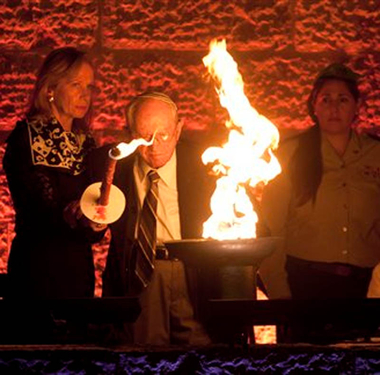The Holocaust: Impossible to comprehend, imperative we never forget

By Rob Howard
Associate Editor
Tonight (May 4) at Sundown, Holocaust Remembrance Day starts. It continues until tomorrow evening. The Holocaust is so terrible, such a stain on humanity, such a massive event in near history, that it is almost impossible to comprehend. 6,000,000 Jews were systematically, brutally murdered by the government, military, and many citizens of Nazi Germany, and citizens from other countries that allied themselves with the Nazis.
In addition, the Nazis murdered at least 5 million other people – Poles, Russian military, homosexuals, Jehovah’s Witnesses and Socialists, as well as thousands of physically or mentally challenged children and adults.
The Holocaust is incomprehensible when you try to embrace the numbers. It is only by the stories of those who experienced it, by visiting museums like the US Holocaust Memorial Museum (USHMM) in Washington, DC, and often by films like Schindler’s List that we can begin to understand.
I had learned much about the Holocaust while in college. And it was my great honor to learn more from one of my aunt’s close friends, Dr. Gisela Konopka, a world renowned social work professor. Gisa, as her friends called her, and her husband Paul, escaped Germany before the major part of the Holocaust. Gisa was Jewish, Paul German, so they could not get married under the 1935 Nuremberg Laws. Those racist laws excluded Jews from German citizenship, forbade them to marry those “of German or related blood,” and many other restrictions.
Both fled Germany. According to a paper published by the University of Minnesota in 2000, “She and Paul joined the resistance movement leading to life and death involvement in underground work. Both were imprisoned at various times (she was seized in 1936 and put in the HamburgFuhlsbuttel concentration camp) and, eventually, had to flee the country. Paul, hunted by the Nazis, escaped in 1936 and made his way to France. Later, Gisela went to Austria to do more underground work, but, after another imprisonment, fled to France where she eventually connected again with Paul where they lived in hiding.
“In the spring of 1941, they emigrated to the U.S., Gisela three months earlier than Paul. They married three days after his arrival in New York.” It was my honor to know them both through the years.
In 2005, the Cimarron Alliance Foundation was planning to host the USHMM exhibit “Nazi Persecution of Homosexuals,” and a companion exhibit, “Rescuers: Portraits of Moral Courage in the Holocaust,” by Gay Block and Malka Drucker of people who helped save the lives of Jews in Europe during the war.
I was a member of the board, and was asked to become chair of the exhibition, a task I gladly accepted. Two of the first people I met in this endeavor were Michael and Joan Korenblit. Michael’s parents, Manya and Meyer, then both alive, were Holocaust survivors. Michael wrote a book about their lives under Nazi oppression, Until We Meet Again. It tells his parents’ compelling and amazing story of surviving the Holocaust, against all odds, through concentration camp imprisonment and death marches.
Manya and Meyer lost almost all of their relatives – mothers and fathers, aunts and uncles, cousins and siblings in the Holocaust. Years later, Michael discovered that one of his mother’s brothers had survived and was living in England
Until you have read a book like Until We Meet Again, you really cannot even begin to understand what millions went through and few survived.
Among the Holocaust survivors in our region is 93-year-old Jack Repp. According to the Fort Worth Star-Telegram, Repp was only 15 when his Jewish family in Poland was torn apart by the Nazis.
According to the paper, reporting in 2012, “’Hitler took everything from me, but he did not take my mind,’ Repp said.
“He was at Bailey Junior High School, where eighth-graders have been studying the history of the Holocaust, writing reports, creating chilling art pieces and reading The Diary of Anne Frank.
"’Being able to bring a Holocaust survivor in here brings it all home to them,’ said English teacher Colleen Bond. ‘ They've been looking forward to his visit and asking, 'When's he coming?'’
“Repp, who was born Jick Rzepkiecz in Radom, Poland, told of the six years of forced labor, death marches, starvation, beatings, illness and the cruel games of his Nazi captors that he endured until he was liberated when he was 21.
“Of his four brothers, one sister and their parents, only he and his sister Nanette survived. She had married and moved to Paris before the war. Four years after it ended, he found her hidden away as a nun there, and her daughter was hidden in an orphanage.
Repp came to America in 1949, and was a businessman in North Texas for 44 years. “Now he talks to schools, colleges, religious and military groups at least once a week as part of the Dallas Holocaust Museum's speakers series,” the Star-Telegram reported.
Even at his advanced age, Jack Repp continues to tell his stories from his experience in the Holocaust, because people need to know, and never forget.
So tonight and tomorrow, we observe Holocaust Remembrance Day. It is the first new Jewish holiday in 2,000 years, according to the Chicago Tribune, established after the war. We think of holidays as days to celebrate, but in this case it is a day to remember, and to say “Never Again!”
You can order a copy of Until We Meet Again through the USHMM bookstore, or on Amazon.com.
The Gayly – May 4, 2016 @ 4:30 p.m.





